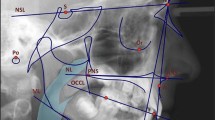Abstract
Objective
The aim of this case control study was to evaluate which cephalometric variables related to craniofacial morphology discriminate between snoring and non-snoring or any other respiratory disease subjects.
Materials and Methods
Total 42(21 snoring and 21 non-snoring) cephalometric measurements were determined to study the craniofacial morphology. Non-snoring subjects were matched to snoring subjects by age, sex, and body mass index. Snoring was assessed using a sleep behavior questionnaire administered to the patients. The cephalometric radiographs of the study subjects were traced by a single investigator, and 1 angular measurement and 13 linear measurements of hard and soft tissues were recorded. The paired Student’s t test was used to analyze the cephalometric data.
Results
Vertical position of the hyoid (MP-H) was significantly longer (P<0.05) in snoring subjects (23.44±14.892mm) than non-snoring subjects (12.89±4.540mm). Anterior overbite and anterior over-jet of snoring group ((4.81± 3.265 and 5.83±8.59) were significantly higher (P<0.05) than non-snoring group (0.67±1.441 and 0.54±1.138). No significant differences of the other [11] cephalometric variables were found within groups.
Conclusion
Snoring subjects appear to present craniofacial factors that differ from those of non-snoring subjects, and we suggest obtaining cephalogram for diagnosis and following up of them.
Similar content being viewed by others
References
Ulfberg J, Carter N (1996) Excessive daytime sleepiness at work and subjective work performance in the general population and among heavy snorers and patients with Obstructive sleep apnea. Chest 110:659–663.
Valbuza JS, Oliveira M. (2008) Methods to increase muscle tonus of upper airway to treat snoring: systematic review. Arq Neuro-Psiquiatr 66(3):101.112
Woodhead CJ, Davies JE, Allan MB (1991) Obstructive sleep apnea in adults presenting with snoring. Clin Otolaryngol 16:401–405.
Katsantonis GP, Schweitzer PK, Branham GH, Chambers G, Walsh JK (1988) Management of obstructive sleep apnea: comparison of various treatment modalities. Laryngoscope; 98:304–309.
Maniglia AJ (1993) Sleep apnea and snoring: an overview. Ear, Nose Throat J 72:16–19.
Fairbanks DNF, Fujita S (1987) Snoring and obstructive sleep apnea, Raven Press1:1–18.
Ah-See KW, Banham SW (1998) Systematic analysis of snoring in women. Ann Otol, Rhinol Laryngol 107:27–31.
British Snoring & Sleep Apnea Association. (1998) What is snoring? Chipstead: BSSA.
Battagel JM, Amandeep J, Kotecha B.A (2000) cephalometric comparison of subjects with snoring and obstructive sleep apnea. European journal of orthodontics 22:353–365.
Fairbanks (1990) DNF. UVPP complications and avoidance strategies. Otolaryngol Head Neck Surg 102:239–245.
Stradling JR, Crosby JH (1991) Predictors and prevalence of obstructive sleep apnea and snoring in 1001 middle aged men. Thorax 46:85–90.
Braver HM, Block AJ, Perri MG (1995) Treatment for snoring. Combined weight loss, sleeping on side and nasal spray. Chest 107:1283–1288.
Hoijer U, Ejnell H, Hedner J, Petruson B, Eng LB (1992) The effect of nasal dilation on snoring and obstructive sleep apnea. Arch Otolaryngol Head Neck Surg 118:281–284.
Wenzel M, Schonhofer B, Siemon K, Kohler D (1997) Nasal strips without effect on obstructive sleep apnea and snoring. Pneumologie 51:1108–1110.
Partinen M, Palomaki H (1985) Snoring and cerebral infarction. Lancet 2: 1325–1326.
Haraldsson PO, Carenfelt C (1995) Does uvulopalatopharyngoplasty inhibit automobile accidents? Laryngoscope 105:1–5.
lee SA, Amis TC, Byth K (2008) Heavy snoring as a cause of carotid artery atherosclerosis. Ludwig Engel Centre for Respiratory Research 31(9):1207–1213.
Cuccial A, Campisi G (2007) Obesity and craniofacial variables in subjects with obstructive sleep apnea syndrome: comparisons of cephalometric values. Head & Face Medicine 3:41–50.
Jennum P, Sjol A (1992)Epidemiology of snoring and obstructive sleep apnoea in a Danish population, age 30–60. J Sleep Res. 1:240–44.
Young T, Palta M (1993) The occurrence of sleep disordered breathing among middle-aged adults. N Engl J Med. 328:1230–5.
Taub, Peter J. Cephalometry (2007) The journal of craniofacial surgery 18(4): 811–817.
Bennett LS, Davies RJO (1998) Oral appliances for the management of snoring and obstructive sleep apnea. Thorax 53(2):58–64.
Nelson S, Hans M (1997) Contribution of craniofacial risk factors in increasing apneic activity among obese and nonobese habitual snorers. Chest 111:154–162.
Partinen M, Guilleminault C (1988) Obstructive sleep apnea and cephalometric roentgenograms: the role of anatomic upper airway abnormalities in the definition of abnormal breathing during sleep. Chest 93: 1199–1205.
Am J, Respir C (2000) Upper Airway Collapsibility and Cephalometric Variables in Patients with Obstructive Sleep Apnea. Care Med 161: 347–352.
Pracharktman N, Hans MG (1994) Upright and supine cephalometric evaluation of Obstructive sleep apnea syndrome and snoring subjects. Angle orthodontist 64:63–72.
Battagel JM (1996) The cephalometric morphology of patient with Obstructive sleep apnea. European journal of orthodontics 18:557–567.
Tsuchiya M, Lowe AA (1992) Obstructive sleep apnea subtypes by cluster analysis. American Journal of orthodontics and dentofacial orthopedics 101:533–542.
Andersson L. Brattstrom V (1991) cephalometric analysis of permanently snoring patients with out Obstructive sleep apnea syndrome. international journal of oral and maxillofacial surgery 20:159–162.
Jones TM, Earis JE (2005) Snoring surgery: a retrospective review. Laryngoscope 115:2010–2015.
Brietzke SE, Mair EA (2006) Acoustical analysis of snoring: can the probability of success be predicted? Otolaryngol Head Neck Surg 135:417–420.
Acebo C, Richard P (1996) Sleep, Breathing, and Cephalometrics in older Children and Young Adults: Part I-Normative Values. Chest 109:664–672.
Faber CE, Grymer L (2003) Available techniques for objective assessment of upper airway narrowing in snoring and sleep apnea. Sleep Breath. Jun;7(2):77–86.
Partinen M, Guilleminault C (2006) Obstructive sleep apnea and cephalometric roentgenograms, The role of anatomic upper airway abnormalities in the definition of abnormal breathing during sleep. Stanford University School of Medicine:420–422.
Kulnis R, Nelson S, Strohl K, Hans M (2000) Cephalometric Assessment of Snoring and Nonsnoring Children. Chest. Sep;118(3):596–603.
Author information
Authors and Affiliations
Corresponding author
Rights and permissions
About this article
Cite this article
Nikakhlagh, S., Tahmasebi, M., Badri, R. et al. Craniofacial variables in subjects with and without habitual snoring: A cephalometric comparison. Indian J Otolaryngol Head Neck Surg 62, 304–309 (2010). https://doi.org/10.1007/s12070-010-0089-2
Published:
Issue Date:
DOI: https://doi.org/10.1007/s12070-010-0089-2




